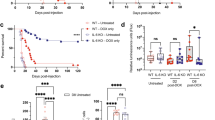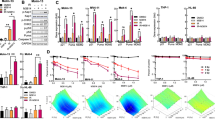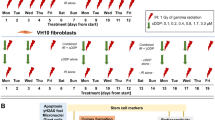Abstract
This report examines the cytotoxicity of chemotherapeutic agents to primary bone marrow-derived IL-3-dependent cells. Such cells derived from p53-null mice were resistant to almost 100-fold higher concentrations of the inhibitors of deoxyribonucleotide synthesis FUdR, methotrexate and hydroxyurea than cells with wild-type p53. In contrast, the cytotoxicity of the DNA damaging agents X-irradiation, cisplatin or bleomycin was p53-independent. The topoisomerase II inhibitor etoposide induced p53-dependent death, which suggests that DNA damage may not be its primary mechanism of cytotoxicity in this cell type. An IL-3-dependent cell line which expresses wild-type p53 was used to demonstrate that the ability of cytotoxic drugs to increase p53 expression level does not control their ability to induce p53-dependent loss of clonigenicity. Finally, comparison with a p53-null IL-3-dependent cell line was used to show that absence of p53 delays the rate of entry into apoptosis following treatment with either DNA damaging agents or inhibitors of deoxyribonucleotide synthesis. This distinguishes short-term effects of p53 on rate of entry into apoptosis from its role in controlling ultimate cell survival.
This is a preview of subscription content, access via your institution
Access options
Subscribe to this journal
Receive 50 print issues and online access
$259.00 per year
only $5.18 per issue
Buy this article
- Purchase on Springer Link
- Instant access to full article PDF
Prices may be subject to local taxes which are calculated during checkout


Similar content being viewed by others
References
Agami R, Blandino G, Oren M and Shaul Y. . 1999 Nature 399: 809–813.
Aladjem MI, Spike BT, Rodewald LW, Hope TJ, Klemm M, Jaenisch R and Wahl GM. . 1998 Curr. Biol. 8: 145–155.
Ascaso R, Marvel J, Collins M and López-Rivas A. . 1994 Eur. J. Immunol. 24: 537–541.
Bunz F, Hwang PM, Torrance C, Waldman T, Zhang Y, Dillehay L, Williams J, Lengauer C, Kinzler KW and Vogelstein B. . 1999 J. Clin. Invest. 104: 263–269.
Clarke AR, Purdie CA, Harrison DJ, Morris RG, Bird CC, Hooper ML and Wyllie AH. . 1993 Nature 362: 849–852.
Collins MKL, Marvel J, Malde P and López-Rivas A . 1992 J. Exp. Med. 176: 1043–1051.
Donehower L, Harvey M, Slagle B, McArthur M, Montgomery C, Butel J and Bradley A. . 1992 Nature 356: 215–221.
Eastman A. . 1987 Pharmacol. Ther. 34: 155–166.
Frenkel J, Sherman D, Fein A, Schwartz D, Almog N, Kapon A, Goldfinger N and Rotter V. . 1999 Oncogene 18: 2901–2907.
Gong JG, Costanzo A, Yang HQ, Melino G, Kaelin Jr WG, Levrero M and Wang JY. . 1999 Nature 399: 806–809.
Gottlieb E, Haffner R, von-Ruden T, Wagner EF and Oren E. . 1994 EMBO J 13: 1368–1374.
Griffiths SD, Clarke AR, Healy LE, Ross G, Ford AM, Hooper ML, Wyllie AH and Greaves M. . 1997 Oncogene 14: 523–531.
Hollenstein M, Sidransky D, Vogelstein B and Harris C. . 1991 Science 253: 49–53.
Ingraham HA, Dickey L and Goulian M. . 1986 Biochemistry 25: 3225–3230.
Kemp L, Sedgwick S and Jeggo P. . 1984 Mutation Res. 132: 189–196.
Lamb JR and Friend SH. . 1997 Nat. Med. 3: 962–963.
Liu L. . 1989 Annu. Rev. Biochem. 58: 351–375.
Loike JD and Horwitz SB. . 1976 Biochemistry 15: 5435–5443.
Lowe SW, Ruley HE, Jacks T and Housman DE. . 1993 Cell 74: 957–967.
Nelson WG and Kastan MB. . 1994 Mol. Cell Biol. 14: 1815–1823.
O'Connor PM, Jackman J, Bae I, Myers TG, Fan S, Mutoh M, Scudiero DA, Monks A, Sausville EA, Weinstein JN, Friend S, Fornace Jr AJ and Kohn KW. . 1997 Cancer Res. 57: 4285–4300.
Oliver FJ, Collins MKL and López-Rivas A. . 1993 Biochem. Biophys. Res. Commun. 194: 126–132.
Oliver FJ, Collins MKL and Lopez-Rivas A. . 1997 J. Biol. Chem. 272: 10624–10630.
Palacios R and Stein Metz M. . 1985 Cell 41: 727–734.
Pritchard DM, Potten CS and Hickman JA. . 1998 Cancer Res. 58: 5453–5465.
Silva A, Wyllie AH and Collins MKL. . 1997 Blood 89: 2717–2722.
Srivastava S, Zou Z, Pirollo K, Blattner W and Chang E. . 1990 Nature 348: 747–749.
Tanizawa A, Kubota M, Hashimoto H, Shimizu T, Takimoto T, Kitoh T, Akiyama Y and Mikawa H. . 1989 Exp. Cell. Res. 185: 237–246.
Tishler RB, Calderwood SK, Coleman CN and Price BD. . 1993 Cancer Res. 53: 2212–2216.
Wlodarski P, Wasik M, Ratajczak MZ, Sevignani C, Hoser G, Kawiak J, Gewirtz AM, Calabretta B and Skorski T. . 1998 Blood 91: 2998–3006.
Zamble DB, Jacks T and Lippard SJ. . 1998 Proc. Natl. Acad. Sci. USA. 95: 6163–6168.
Acknowledgements
Carmen Palacios was the recipient of a fellowship from the Ministerio de Education y Cultura, Spain. Augusto Siwa is funded by a grant SAF97-0063/C03.
Author information
Authors and Affiliations
Rights and permissions
About this article
Cite this article
Palacios, C., del Arroyo, A., Silva, A. et al. The role of p53 in death of IL-3-dependent cells in response to cytotoxic drugs. Oncogene 19, 3556–3559 (2000). https://doi.org/10.1038/sj.onc.1203683
Received:
Revised:
Accepted:
Published:
Issue Date:
DOI: https://doi.org/10.1038/sj.onc.1203683
Keywords
This article is cited by
-
Cyclin D1 mediates resistance to apoptosis through upregulation of molecular chaperones and consequent redistribution of cell death regulators
Oncogene (2008)
-
The role of p53 in determining sensitivity to radiotherapy
Nature Reviews Cancer (2003)
-
Effects of Helicobacter pylori CagA protein on the growth and survival of B lymphocytes, the origin of MALT lymphoma
Oncogene (2003)
-
Role of Bax in apoptosis of IL-3-dependent cells
Oncogene (2001)



